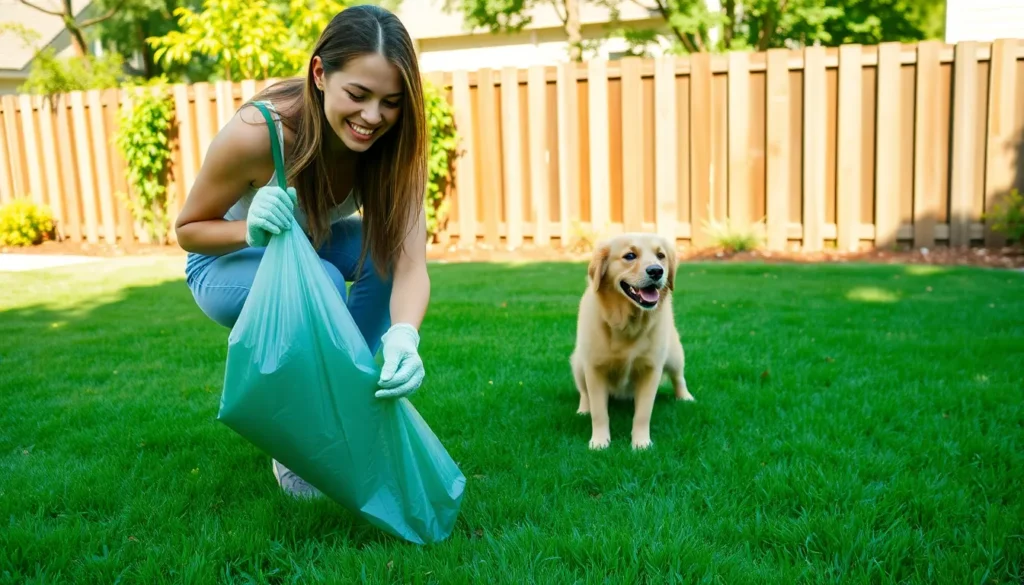Dog obedience is more than just a set of commands; it’s the foundation of a strong bond between a pet and its owner. When dogs understand and respond to basic commands, they become well-mannered companions, leading to a harmonious home environment. Training fosters communication and trust, making it essential for both the dog’s safety and the owner’s peace of mind.
In today’s fast-paced world, many pet owners seek effective strategies to ensure their dogs are well-behaved. With the right techniques, anyone can transform a rambunctious puppy into a disciplined adult dog. This article explores the importance of obedience training, offering insights into methods that promote good behavior and strengthen the human-animal connection. Whether you’re a new dog owner or looking to refine your pet’s skills, understanding dog obedience is the first step toward a happier life together.
Table of Contents
ToggleUnderstanding Dog Obedience
Dog obedience refers to a dog’s ability to respond consistently to commands and cues from its owner. This responsiveness is fundamental for effective communication and a smoother relationship.
Definition of Dog Obedience
Dog obedience encompasses a variety of behaviors where a dog follows commands from its owner and behaves appropriately in various situations. Training focuses on essential commands such as “sit,” “stay,” “come,” and “heel.” These basic commands form the foundation for more advanced training and are vital for ensuring a dog’s safety, especially in public or unpredictable environments.
Importance of Dog Obedience
Dog obedience plays a crucial role in behavioral development and strengthens the owner-pet relationship. Key aspects of its importance include:
- Safety: Trained dogs respond promptly to commands, which can prevent accidents in potentially dangerous situations, such as busy streets.
- Control: Obedience training allows owners to manage their dogs’ behavior effectively, ensuring they remain calm and composed in various settings.
- Socialization: Well-behaved dogs interact better with other pets and people, leading to a more enjoyable experience during walks or at parks.
- Reduced Stress: An obedient dog lowers the owner’s stress levels, enhancing the overall home environment and making daily routines smoother.
Investing time in obedience training not only benefits the dog but also fosters a stronger bond between the owner and pet.
Training Techniques for Dog Obedience

Effective training techniques enhance dog obedience and strengthen the bond between owners and their pets. Here are some widely used methods.
Positive Reinforcement
Positive reinforcement involves rewarding desired behaviors to encourage their repetition. Rewards can include treats, praise, or playtime, depending on what motivates the dog. Using this technique consistently fosters an environment where dogs feel safe and eager to learn.
- Timing is crucial – Provide rewards immediately after the dog performs the desired behavior to create a clear association.
- Gradual progression helps – Start with simple commands. As the dog masters basic behaviors, gradually introduce more complex commands.
- Variety keeps interest – Use different rewards to maintain excitement and motivation. Treats, play, or verbal praise all contribute to successful training.
Clicker Training
Clicker training utilizes a device that makes a clicking sound to mark a desired behavior at the precise moment it occurs. This technique enhances clarity for the dog by providing instant feedback.
- Consistency is key – Use the clicker consistently to maintain clear communication between the dog and owner.
- Establish a foundation – Pair the clicker sound with a reward. Make this connection clear before proceeding to training commands.
- Pace the training – Advance at the dog’s comfort level. Slow down if the dog struggles to understand, allowing for mastery of each step before moving forward.
Utilizing these training techniques fosters an obedient dog, reduces behavioral issues, and strengthens the overall relationship between the dog and owner.
Common Challenges in Dog Obedience
Training dogs presents various challenges that can impact their obedience. Understanding these hurdles helps owners develop effective strategies for successful training.
Behavioral Issues
Behavioral issues often impede obedience training. Common problems include:
- Aggression: Dogs may display aggression towards other animals or people, making training difficult. Addressing this requires understanding triggers and implementing desensitization techniques.
- Fearfulness: Some dogs react to stress or unfamiliar situations with fear, which can hinder their ability to follow commands. Gradual exposure to various environments can help build confidence.
- Hyperactivity: High energy levels can distract a dog from focusing on their training. Engaging in regular exercise and mental stimulation can channel this energy productively.
- Separation Anxiety: Dogs with separation anxiety may struggle to remain calm and respond to commands when left alone. Training sessions focused on desensitization and crate training can assist in alleviating anxiety.
Environmental Distractions
Environmental distractions significantly affect a dog’s ability to obey commands. Key distractions include:
- Noise: Loud sounds, such as traffic or other animals, can divert a dog’s attention away from training efforts. Implementing training in quieter settings gradually helps improve focus.
- Other Animals: The presence of other pets or wildlife can lead to overexcitement or distractions. Controlled socialization with other animals during training can mitigate this challenge.
- New People: New individuals can be engaging for dogs, causing them to lose focus on commands. Ensuring proper introductions and teaching calm behavior can help dogs remain attentive.
- Visual Stimuli: Objects or movements in the environment, including birds or cars, can distract dogs during training. Using visual barriers or training in less stimulating areas can enhance focus.
Addressing these common challenges enhances obedience training and strengthens the bond between dogs and their owners.
Benefits of Dog Obedience
Dog obedience offers numerous advantages that significantly impact the relationship between owners and their pets, along with overall community safety.
Strengthening the Human-Dog Bond
Building a strong connection between a dog and its owner starts with effective communication. Training a dog to follow commands fosters mutual understanding and respect. As dogs learn commands, they gain confidence, knowing how to respond to their owner’s expectations. Consistent training sessions help create shared experiences that deepen the bond. An obedient dog often experiences reduced anxiety, promoting a more secure environment for both the pet and the owner.
Enhancing Safety and Control
Dog obedience plays a crucial role in enhancing safety for both the dog and those around it. Well-trained dogs respond promptly to commands, preventing potentially dangerous situations. Commands like “come” and “stay” can keep dogs away from traffic, allowing for safer outdoor experiences. In social settings, an obedient dog can interact safely with other animals and people, reducing the risk of aggressive behaviors. Effective control through obedience training leads to a more manageable pet, ensuring a pleasant experience for everyone involved.
Dog obedience training is essential for creating a harmonious relationship between pets and their owners. It fosters effective communication and builds trust which enhances safety and reduces anxiety for both parties. By investing time in training techniques like positive reinforcement and clicker training, owners can transform their dogs into well-mannered companions.
Addressing common challenges during training ensures that both the dog and owner can navigate distractions and behavioral issues effectively. The benefits of obedience extend beyond the home, contributing to community safety and a more enjoyable experience for everyone. Ultimately, a well-trained dog not only enriches the owner’s life but also brings joy and security to the entire household.








